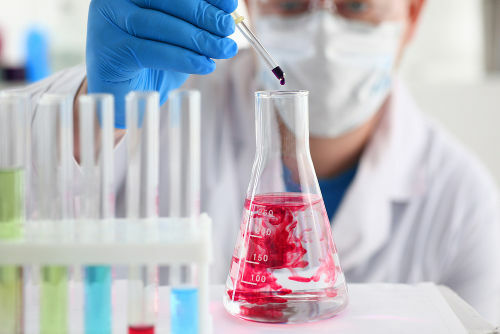perform the calculation of enthalpy of a reaction it means to determine the energy variation that occurred from the mixing of the reactants to the formation of the products. In the equation below, we have the representation of reactants and products
A + B → C + D
A + B = Reagents
C + D = Products
Each participant in a reaction has an enthalpy (H), that is, each participant has a certain amount of energy. During the course of the reaction, bonds between the reactants are broken and bonds between the atoms of the products are formed. In this way, during the chemical reaction, an energy variation is established.
To determine the calculation of the enthalpy of a reaction, it is first necessary to know the individual enthalpies of each of the participants. Normally the exercises always give the enthalpy values of reactants and products. For example:
ZnS+O2 → ZnO + SO2
HZnS = - 49.23 Kcal/mol
HO2 = 0 Kcal/mol
HZnO = - 83.24 Kcal/mol
HSO2 = - 70.994 Kcal/mol
If we had a simple substance, the enthalpy value would be zero. However, it is noteworthy that if the simple substance is an allotrope in the reaction, we must be careful to know if we are dealing with the most stable allotrope of the chemical element that forms this substance. O
allotrope more stable always has an enthalpy of zero, so the exercise will not perform this indication. See a table with the elements that form allotropes and those that are more stable:
NOTE: The most stable allotropic form of the element indicates the substance found in greater quantity in nature.
The calculation of the enthalpy of the reaction is generally called the enthalpy variation and is always represented by the acronym ∆H. As this is a variation, calculating the enthalpy of the reaction involves subtracting the enthalpy of the products from the enthalpy of the reactants:
∆H = HFOR - HR
Calculating the enthalpy variation allows us to identify whether the reaction is endothermic or exothermic. If the result is negative, the reaction will be exothermic; if the result is positive, the reaction will be endothermic.
∆H = - (Exothermic)
∆H = + (Endothermic)
When performing the calculation of the enthalpy variation of a reaction, it is very important that we are very pay attention to the balance, as the enthalpy values provided by the exercise are always expressed in mol. Thus, if the reaction participant has more than one mole, we must multiply its enthalpy value by its amount expressed in the balancing. See an example:
Do not stop now... There's more after the advertising ;)
2 ZnS + 3 O2 → 2 ZnO + 2 SO2
We observe that the coefficients that balance the equation are 2, 3, 2 and 2. Thus, the enthalpy values of each of the participants will be:
HZnS = - 49,23. 2 = - 98.46 Kcal/mol
HO2 = 0. 3 = 0 Kcal/mol
HZnO = - 83,24. 2 = - 166.48 Kcal/mol
HSO2 = - 70,994. 2 = - 141,988 Kcal/mol
From these data, we can calculate the enthalpy variation of the reaction. It is worth remembering that the values of the products must be added together, as well as those of the reagents:
∆H = HFOR - HR
∆H = [(-166.48) + (-141.998)] - [(-98.46) + 0]
∆H = (- 308.468) - (-98.46)
∆H = -308.468 + 98.46
∆H = - 210.008 Kcal/mol
NOTE: As the result was negative, this reaction is exothermic.
Now follow the resolution of a vestibular exercise on calculating the enthalpy of a reaction:
(UFMS) The value of H for the balanced equation below is: Data: HAg2S = - 32.6 KJ/mol, HH2O = - 285.8 KJ/mol, HH2S = - 20.6 KJ/mol,
2 Ag2S + 2 H2O → 4 Ag + 2 H2S + O2
a) 485.6 KJ
b) 495.6 KJ
c) 585.6 KJ
d) 595.6 KJ
e) 600 KJ
The data provided by the exercises are:
NOTE: How do we have the O2 in the equation, which is the most stable allotrope of oxygen, its enthalpy is 0 KJ. As Ag is a simple substance, its enthalpy is worth 0 KJ.
HAg2S = - 32.6 KJ/mol
HH2O = - 285.8 KJ/mol
HH2S = - 20.6 KJ/mol
Taking into account the balance, we must multiply the coefficient by the enthalpy of each of the participants:
HAg2S = - 32,6. 2 = - 65.2 KJ
HH2O = - 285,8. 2 = - 571.6 KJ
HH2S = - 20,6. 2 = - 41.2 KJ
HO2 = 0. 1 = 0 KJ
HAg = 0. 4 = 0 KJ
Finally, just use the data in the enthalpy variation formula:
∆H = HFOR - HR
∆H = [(0) + (-41.2) + 0] - [(-65.2) + (-571.6)]
∆H = (-41.2) - (-636.8)
∆H = -41.2 + 636.8
∆H = 595.6 Kcal/mol
As the result of the variation was positive, the reaction is endothermic.
By Me. Diogo Lopes Dias
Chemistry

Thermochemistry, Enthalpy, Released Heat, Exothermic Reaction, Combustion Reaction, External Environment, Endothermic Reaction, Reaction chemistry, energy exchange, reagents, light emission, light absorption, heat, electricity, components, physical state, products.

